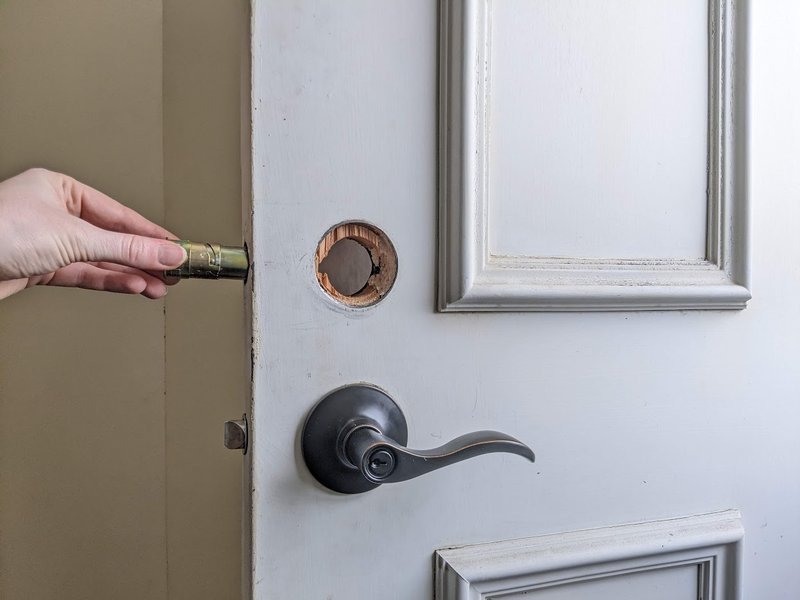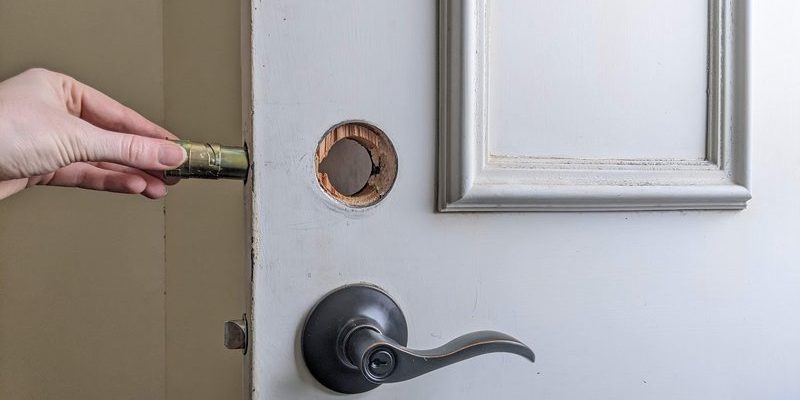
Let me put it this way: If you’ve got a Schlage or Kwikset deadbolt on your front door, you probably trust it to keep your place safe. But these locks don’t last forever, especially when the cam inside takes a beating over the years. If the cam’s broken, it doesn’t matter if your code is solid, your key is synced perfectly, or your battery in a smart lock is fresh—nothing’s moving that bolt. Let’s talk about why cams fail, how you can spot the problem, and most importantly, how to fix a broken cam on your exterior deadbolt, step by step.
What Is a Deadbolt Cam and Why Does It Matter?
The cam is a small but mighty piece inside your deadbolt lock. It’s the flat or curved metal part that turns when you use your key (or sometimes the knob on the inside). Picture it as the little arm that grabs and shifts the bolt into place—almost like the gear in a clock. Without a working cam, your key just spins or jams, and honestly, you might as well be poking at the lock with a toothpick.
Why does this tiny part matter so much? Here’s the thing: *the cam actually connects the key cylinder to the bolt mechanism itself*. When you turn your key, the cam rotates and either pulls or pushes the bolt. If that cam breaks, the connection between the cylinder and the bolt is lost. That’s why your key might turn with zero resistance, or worse, jam in place. In some designs—especially with brands like Schlage, Defiant, or Kwikset—the cam is removable or replaceable. In others, it’s riveted and not meant to be replaced easily, but with the right know-how, you can still get the job done.
You might be wondering why these cams fail. Most often, it’s metal fatigue, corrosion, or just plain old wear and tear. Sometimes a botched attempt to sync a smart lock cylinder or a forced key can snap the cam, especially if you’ve used extra torque. The bottom line? A broken cam turns your solid security system into a fancy door ornament.
Signs Your Deadbolt Cam Is Broken
If your exterior deadbolt suddenly stops working, don’t panic. Most symptoms of a broken cam are pretty easy to spot if you know what to look for. Here’s how you can tell if the cam is your problem—not the key or the rest of the lock.
- The key turns, but the bolt doesn’t move: This is the classic giveaway. If the key feels loose or spins endlessly, your cam might not be grabbing the bolt at all.
- Difficulty removing the key: If your key is tough to pull out or constantly gets stuck, it can mean the cam isn’t aligned with the cylinder anymore.
- Deadbolt knob works, but the key doesn’t: This points to a cam or connection problem with the exterior side, especially if the interior knob feels normal.
- Visible damage or rattling inside: If you hear loose parts when you jiggle the lock or see pieces falling out during troubleshooting, your cam has likely snapped or detached.
Honestly, the symptoms can mimic a lost remote code, drained battery (in an electronic deadbolt), or even a simple misalignment. Before you start blaming your brand or think you need to reset, give the cam a closer look—it’s probably the missing link.
Tools and Supplies You’ll Need for Cam Repair
You don’t need a full workshop to repair a broken cam on an exterior deadbolt. Most jobs require a few basic tools most homeowners already have. Before you dig in, make sure you have the following:
- Screwdriver set: Phillips and flat-head sizes for removing lock screws and plates.
- Replacement cam: Get one that matches your lock’s brand and model—Schlage, Kwikset, Defiant, and Yale cams often differ by shape and fit.
- Small pliers: For grabbing small parts or springs inside the lock housing.
- Pen and paper or a smartphone: Take photos or notes as you disassemble, especially for code or sync wires if your lock is electronic.
- Lubricant: Use graphite or a silicone-based spray to keep the parts moving smoothly once reassembled.
It’s smart to lay everything out before you start. Losing a tiny screw can mean a second trip to the hardware store. If you’re dealing with an electronic deadbolt, don’t forget to remove the battery first—nobody likes an accidental electric zap or code reset while they’re working.
Step-By-Step: Repairing a Broken Cam on Your Deadbolt
Let me walk you through this repair, nice and slow. Even if you’ve never taken apart a lock before, you’ll get there with a methodical approach. Here’s what to do:
- Remove the lock from the door: Start by unscrewing the two mounting screws on the interior plate (the part inside your house). Set the screws aside safely. Gently pull the lock apart—don’t force anything.
- Detach the cylinder: Take out the cylinder that houses your keyhole. In brands like Schlage, there’s usually a retaining clip or screw holding it in place. Use pliers or a screwdriver to pop it out.
- Inspect the cam: Now you’re at the heart of the issue. Check if the cam is broken, bent, or missing. If you see a cracked piece of metal or plastic, that’s your sign.
- Replace the cam: Swap the damaged cam with your new one. Make sure the orientation matches the original—cams can look similar but function completely differently if installed upside down.
- Reassemble the lock: Put everything back in reverse order. Double-check your notes or photos to keep sync with how everything was before. Tighten the screws, but don’t overtighten. If it’s electronic, reinstall the battery but check your code and pairing before fully securing the housing.
- Test it: Before calling it done, test both the key and the inside knob several times to make sure the bolt slides smoothly. If you’re still having issues, double-check that the cam is seated properly and nothing’s misaligned.
Here’s an insight for beginners:
Be patient and stay organized. Small deadbolt parts can be frustrating, but careful work pays off with a lock that’ll last for years.
Common Problems During Deadbolt Cam Repair
Here’s the honest truth: things don’t always go according to plan when you’re fixing a deadbolt cam. You might hit a snag or two, but don’t let that stop you. Some issues are pretty common, especially for beginners.
One typical issue is losing small springs or clips inside the lock. These tiny parts can pop out and disappear faster than a remote under a couch cushion. My advice? Work over a baking sheet or towel to catch loose bits. Another headache: the cam doesn’t fit or turns the wrong way. This often happens if you buy a universal cam that doesn’t exactly sync with your lock brand. When in doubt, bring the old cam to your hardware store and compare before buying.
Then there’s the bolt getting stuck, even after reassembly. If your bolt won’t move smoothly or you hear grinding, it might need a quick reset. Try loosening the screws slightly and wiggling the cylinder—sometimes the cam needs a touch of play to settle in.
If you’re working with a smart deadbolt, there’s another layer of troubleshooting: *code resets and battery issues.* Always take out the battery and double-check any pairing or programming steps before reassembly. Trust me, you don’t want to have to take the whole thing apart a second time just to sync a remote.
Comparing OEM vs. Universal Cams: What Should You Choose?
You might be tempted to grab the cheapest cam off the rack or order a “universal” kit online. There are pros and cons to each option. Here’s what you should know:
- OEM cams: These are made by the same company as your lock (like Schlage or Kwikset). They’re built to spec, so you know the fit and function will be perfect. The downside? They’re sometimes pricier or harder to find locally.
- Universal cams: These try to cover multiple lock types. They can work in a pinch, especially for older or off-brand locks. But here’s the catch: the fit can be sloppy, leading to long-term reliability problems or even damage to your bolt if it doesn’t sync just right.
If you care about the quality and longevity of your exterior deadbolt (and honestly, who doesn’t, since it’s your front door?), stick with the brand-specific part. But if you’re troubleshooting an emergency, a universal cam can be a quick fix—just watch for compatibility issues.
When to Replace the Whole Deadbolt Instead
Sometimes, no amount of cam repair, code resets, or troubleshooting will save an old deadbolt. You might feel attached to your trusty lock, but here’s the thing: if the cylinder or bolt is badly worn, or if you can’t find the right cam, it’s often smarter and safer to replace the lock entirely.
You should also consider a full replacement if:
- The bolt remains jammed even after cam replacement.
- There is visible corrosion or major wear on other parts.
- It’s a very old model, and replacement parts are hard to source.
- You’ve upgraded your home security and want a lock that supports smart functions—like remote control, code entry, or battery backup.
Honestly, installing a new deadbolt isn’t much harder than replacing the cam. Most kits (especially from brands like Schlage and Kwikset) come with step-by-step instructions and only need basic tools. Plus, you get a fresh start—no more worn-out parts or awkward troubleshooting.
Keeping Your Deadbolt in Top Shape After Repair
Repairing the cam on your exterior deadbolt is only half the battle. Regular maintenance goes a long way toward keeping your lock reliable and safe. Here’s how to keep things running smoothly:
- Lubricate yearly: Use graphite or a lock-specific lubricant. Avoid WD-40 or oil-based sprays—they can gum up the works over time.
- Avoid forcing the key: If things feel sticky, investigate rather than muscle your way through. Forcing can snap even the strongest cam.
- Check the battery on smart locks: Low batteries can mimic mechanical issues—always check your battery status and replace as needed.
- Sync and reset codes as needed: For electronic models, make sure your codes, remotes, and pairing are up to date to avoid access headaches.
A little TLC makes a big difference. Taking five minutes now can save you the headache of another cam repair or, worse, a lockout when you least expect it.
Final Thoughts on Fixing and Upgrading Deadbolts
Fixing a broken cam on your exterior deadbolt might seem intimidating at first, but it’s totally doable with a little patience and the right tools. Whether you’re working with a classic Schlage, a budget Defiant, or a high-tech Kwikset smart lock, the core ideas are the same: diagnose the problem, use a matching cam, and reassemble carefully. Don’t rush—it’s your home’s first line of defense, after all.
If you run into trouble, don’t hesitate to call a locksmith or head to the hardware store for expert help. Sometimes, replacing the whole deadbolt is the safer and easier route. Either way, understanding how your deadbolt works—and how to fix it—means you’ll never feel helpless at your own door. That’s peace of mind you can trust, every single time you turn the key.
